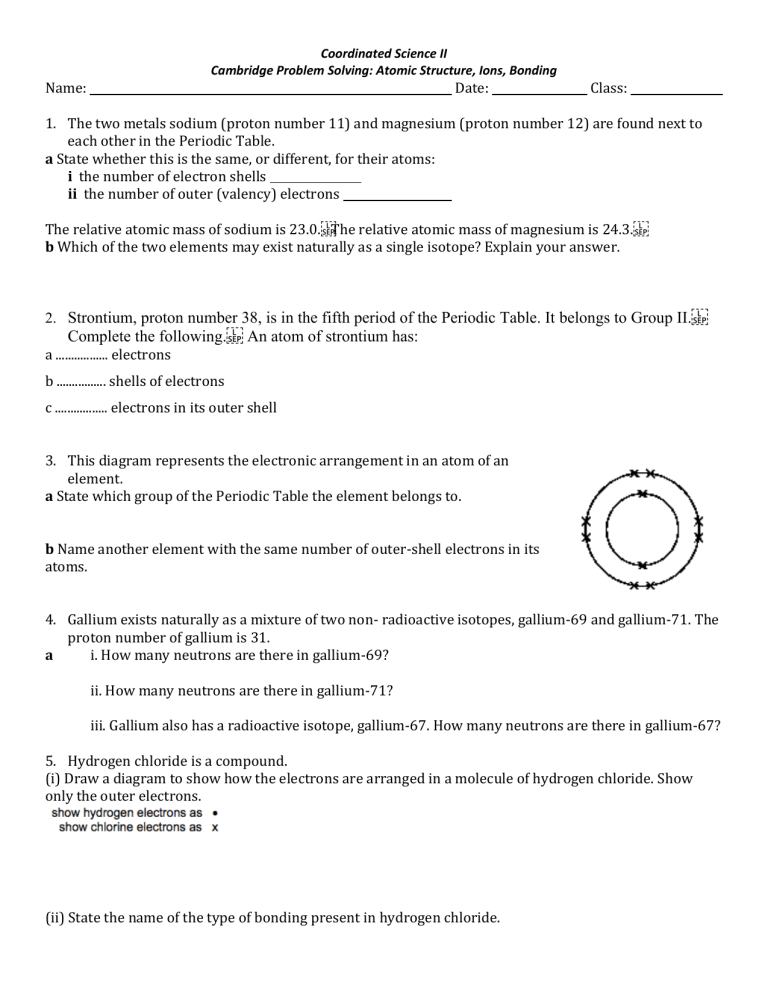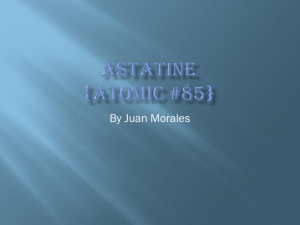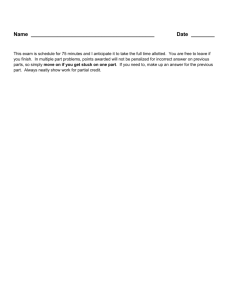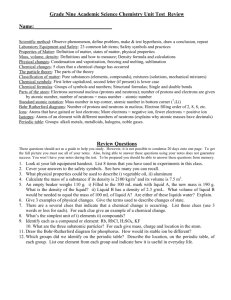Coordinated Science II Cambridge Problem Solving: Atomic

Coordinated Science II
Name:
Cambridge Problem Solving: Atomic Structure, Ions, Bonding
Date: Class:
1.
The two metals sodium (proton number 11) and magnesium (proton number 12) are found next to each other in the Periodic Table.
a State whether this is the same, or different, for their atoms:
i the number of electron shells
ii the number of outer (valency) electrons
The relative atomic mass of sodium is 23.0.
The relative atomic mass of magnesium is 24.3.
b Which of the two elements may exist naturally as a single isotope? Explain your answer.
2.
Strontium, proton number 38, is in the fifth period of the Periodic Table. It belongs to Group II.
Complete the following. An atom of strontium has:
a ................. electrons b ................ shells of electrons c ................. electrons in its outer shell
3.
This diagram represents the electronic arrangement in an atom of an element.
a State which group of the Periodic Table the element belongs to.
b Name another element with the same number of outer-shell electrons in its atoms.
4.
Gallium exists naturally as a mixture of two non- radioactive isotopes, gallium-69 and gallium-71. The
a proton number of gallium is 31. i. How many neutrons are there in gallium-69? ii. How many neutrons are there in gallium-71? iii. Gallium also has a radioactive isotope, gallium-67. How many neutrons are there in gallium-67?
5.
Hydrogen chloride is a compound.
(i) Draw a diagram to show how the electrons are arranged in a molecule of hydrogen chloride. Show only the outer electrons.
(ii) State the name of the type of bonding present in hydrogen chloride.
Coordinated Science II
Cambridge Problem Solving: Atomic Structure, Ions, Bonding
6.
Look at the list of five elements below. argon bromine chlorine iodine potassium
(a) List these five elements in order of increasing proton number.
(b) List these five elements in order of increasing relative atomic mass.
(c) Which of the five elements in the list are in the same group of the Periodic Table?
(d) From the list, choose one element which has one electron in its outer shell.
(e) From the list, choose one element which has a full outer shell of electrons.
(f) Describe the change in the electronic structure of potassium and chlorine atoms when they combine to make potassium chloride.
7.
The structures of some substances containing halogens are shown below.
(i) Which one of these structures, A, B, C or D, shows an element? [1] _____________
(ii) Which one of these structures forms hydrochloric acid when dissolved in water? [1] _____________
(iii) Complete the following sentence. Structure B conducts electricity when it is molten because…
(iv) Which structure contains ions? _____________
8.
Astatine, At, is below iodine in Group VII of the Periodic Table.
(i) In which Period of the Periodic Table is astatine? [1] _____________
(ii) How many protons does astatine have in its nucleus? [1] _____________
(iii) Astatine has many isotopes. What do you understand by the term isotopes? [1]
(iv) The most common isotope of astatine has a nucleon number (mass number) of 210. Calculate the number of neutrons in this isotope of astatine. _____________








